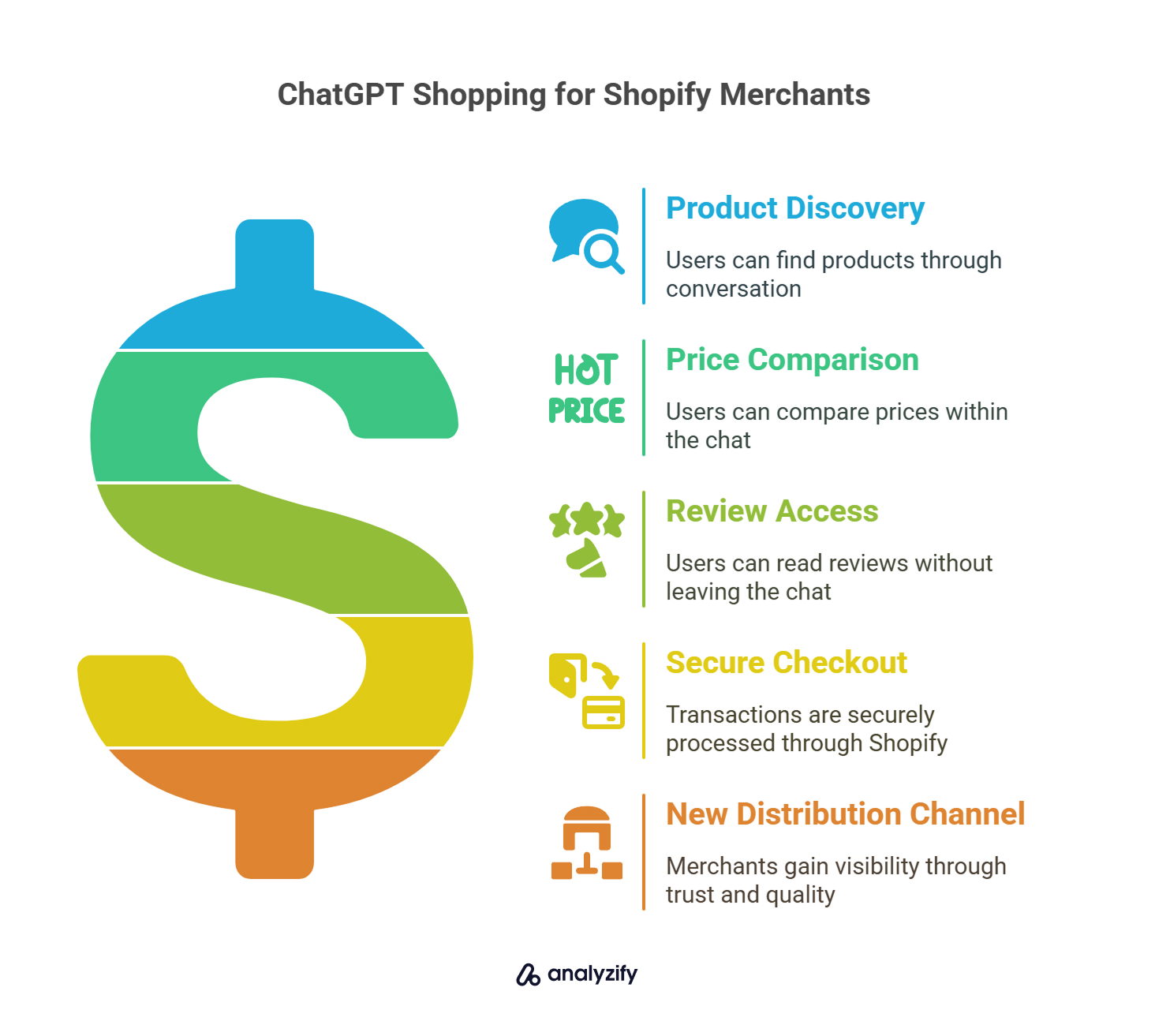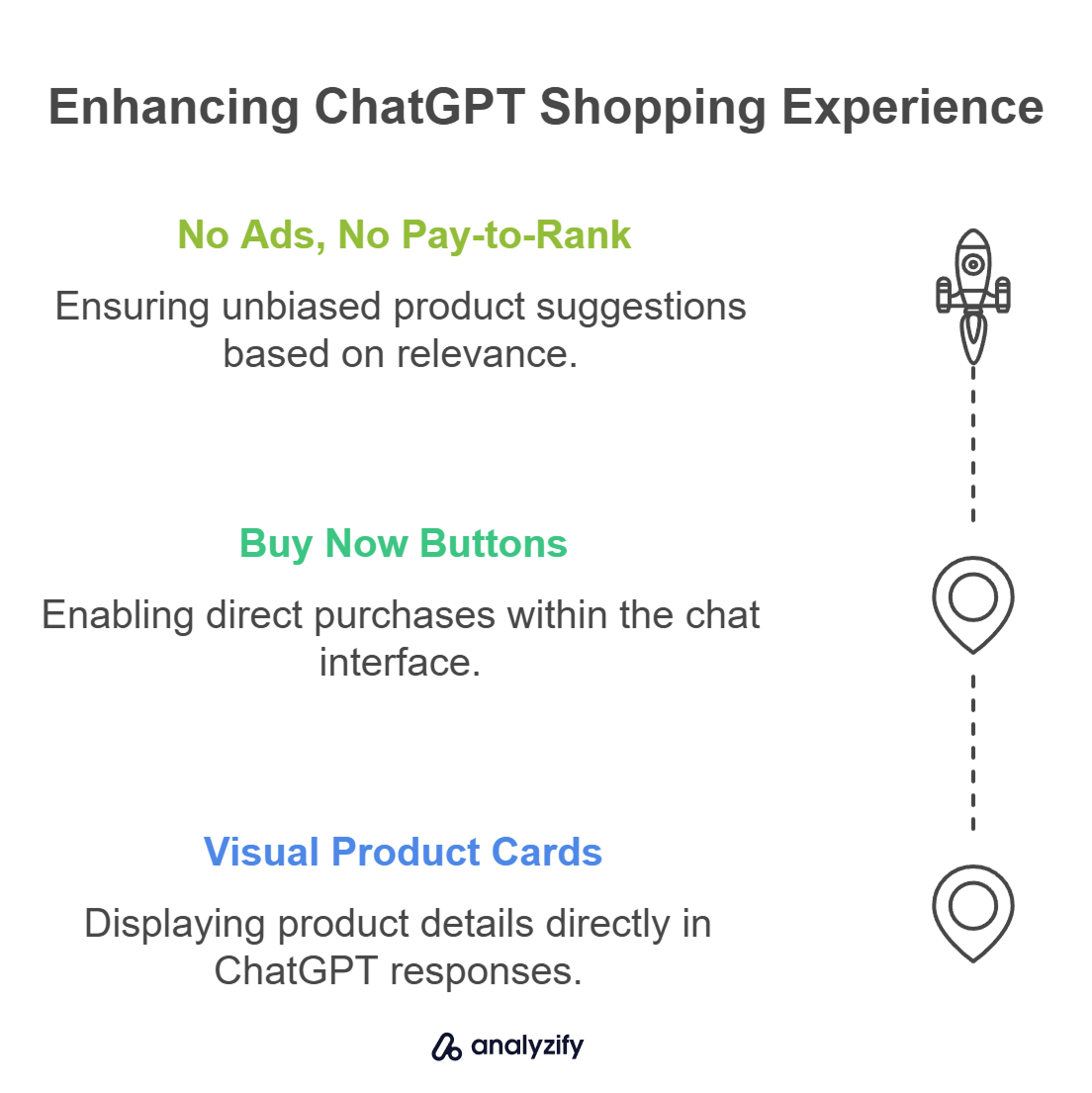Something quietly revolutionary is underway: ChatGPT is no longer just answering questions — it’s starting to help users discover, compare, and even buy products directly inside a conversation.
Through a new integration with Shopify, ChatGPT is beginning to show product options with pricing, reviews, and checkout links — all from within the chat interface.

Here’s what just changed — and why it matters:
Shopping is no longer tied to traditional search. Users can now ask ChatGPT for a product recommendation and complete the purchase on the spot.
Shopify stores are powering the backend. The checkout process still happens securely through Shopify, but it feels like the entire journey happens inside ChatGPT.
This creates a new distribution channel for merchants — one where visibility is earned through trust and product quality, not through ad spend.
If your brand relies on Google Search, social media, or marketplace listings to get discovered, it’s time to ask a different question:
What happens when the customer journey no longer starts with a click — but with a conversation?
What’s New: ChatGPT Now Supports In-Chat Shopping with Shopify
OpenAI has officially started rolling out a native shopping experience inside ChatGPT — and Shopify is at the core of it. This isn’t just about showing product links or redirecting users. It’s a full in-chat commerce experience, designed to remove friction from the buying process.

Here’s what the new experience includes:
Visual product cards with names, images, prices, and user reviews — shown directly in ChatGPT responses.
“Buy Now” buttons that trigger a Shopify-powered checkout flow, without ever leaving the conversation.
No ads, no pay-to-rank. Product suggestions are currently generated based on relevance and structured data, not sponsorship.
While the integration is still in early rollout, users across all plans — including Free — are already starting to see these features.
Code strings like buy_now, product_offer_rating, and shopify_checkout_url found in ChatGPT’s public bundle confirm what’s coming next: a fully embedded shopping flow where the product search, selection, and purchase all happen in one place.
For Shopify merchants, this means something simple but powerful: Your store can now show up where conversations happen, not just where people search.
Bonus: Learn more about Latest ChatGPT Statistics (2025)!
How ChatGPT Is Replacing Traditional Product Discovery
This update isn’t just a UI enhancement — it’s a fundamental shift in how online shopping works.
Traditionally, the customer journey moves through multiple stages:
Discovery via search engines or ads
Comparison across websites, reviews, and marketplaces
Purchase through brand websites or platforms like Amazon
ChatGPT collapses all three into a single conversation. Users don’t need to jump between tabs, scroll through filters, or click on multiple ads to find what they need. They simply ask a question — and get personalized, purchase-ready recommendations in real time.

Here’s why that changes the game:
- It bypasses traditional platforms. Shoppers can now skip Google, Meta, and even Amazon — getting directly to a relevant product without leaving the chat.
- It reduces friction. There’s no funnel to navigate, just one interaction that goes from intent to checkout.
- It mimics personal shopping. The AI doesn’t just list products — it explains why each one fits the user’s context.
More than 1 billion searches now happen inside ChatGPT each week, and a growing share of those involve commercial intent. This isn’t experimental — it’s already changing user behavior.
If your brand has been investing in ads or SEO to “capture intent,” it’s time to consider a new reality: What if the intent never leaves the chat window?
How to Prepare Your Shopify Store for ChatGPT Shopping
With ChatGPT now serving product results directly in the conversation, Shopify stores face a new kind of opportunity — and a new set of challenges. The usual channels like paid ads and SEO still matter, but they’re no longer the only way to get discovered.
Here’s what changes for Shopify merchants:
✅ Your Product Data Determines Your Visibility
ChatGPT pulls structured product data — titles, descriptions, images, pricing, reviews — from your Shopify store to populate its responses.
If that data is missing, messy, or inconsistent, your products may not appear at all.
- Make sure product titles and descriptions are clear and specific.
- Use high-quality images and enable customer reviews.
- Keep pricing and availability up to date.
✅ Visibility Comes From Trust, Not Ad Spend
OpenAI has confirmed that results are not influenced by advertising — at least for now.
Instead, the system favors sources that are perceived as trustworthy and consistent.
- Brands with strong reputations across platforms (Shopify, social, press) are more likely to surface.
- Building authority through content, reviews, and community matters more than ever.
- Your “brand footprint” now plays a role in conversational discovery.
✅ You’re No Longer Just Competing on Search
Customers can now discover your products without typing a search query into Google or browsing Amazon.
They may never visit your site unless the AI brings them there.
- Think of ChatGPT as a new sales channel — one that works by understanding context, not keywords.
- The playing field has shifted: visibility depends on data quality, brand perception, and how helpful your content is inside conversations.
Bonus: Explore ChatGPT Image Generator use cases for ecommerce!
Will ChatGPT Replace Google or Amazon for Product Discovery?
That might sound dramatic — but the fundamentals are already changing.For years, brands have focused on two key moments in the customer journey:
- At the beginning, they try to get discovered through Google searches, SEO content, and paid ads.
- At the end, they compete for conversions on platforms like Amazon, through product listings, review sites, and retargeting campaigns.
Now, ChatGPT is quietly inserting itself into both.
- It captures intent early, when a user casually asks, “What are good running shoes under $100?”
- It drives conversions directly, by offering tailored suggestions with pricing, reviews, and one-click checkout through Shopify.

This shift is part of a larger trend: AI tools are becoming agentic — meaning they don’t just assist users; they act on their behalf. And users seem ready for it. The AI in ecommerce market is projected to reach $64 billion by 2034, growing at over 24% CAGR.
The platforms are changing fast:
- Amazon is testing “Buy for Me,” an AI shopping assistant that purchases from third-party stores.
- Perplexity allows users to shop from product cards inside its AI-powered answers.
- Microsoft Copilot is integrating ecommerce into its broader AI ecosystem.
What makes OpenAI and Shopify different?They’re building the first conversational-first path to checkout — with no ads, no redirects, and no search results in between.
This doesn’t mean Google and Amazon will disappear — but it does mean they may no longer control how discovery begins.
What Should You Do Right Now as a Shopify Brand?
If ChatGPT continues integrating Shopify checkout directly into conversations, your store may already be eligible to appear in front of users — or be silently left out.
Here’s how to prepare and stay ahead:
1. Audit Your Product Data
What ChatGPT shows depends on what Shopify provides. Incomplete, outdated, or vague product info won’t make the cut.
- Review your titles, descriptions, and images for clarity and relevance.
- Make sure reviews and ratings are active and visible.
- Ensure stock, pricing, and shipping info are accurate — these are all fields ChatGPT can surface.
2. Build a Brand That Feels Trustworthy
OpenAI has stated that products are not ranked by ads — but by credibility and consistency. Your visibility depends on how trustworthy your brand appears across the web.
- Strengthen your presence across multiple platforms (Shopify, social, PR, etc.).
- Maintain consistency in tone, messaging, and visuals.
- Encourage user-generated content and reviews — they add context AI can use.
3. Stay Informed, Stay Adaptable
ChatGPT’s shopping capabilities are still changing, and so are the rules for how products are shown.
- Monitor OpenAI’s updates and Shopify announcements.
- Test prompts in ChatGPT to see what’s being shown — and what’s missing.
- Be ready to adapt — early movers often benefit most when platforms change.
In short, don’t treat this like just another channel. This is a shift in how customers discover and decide — and it’s happening in real time.
How to Get Your Brand Featured Inside ChatGPT Recommendations
As shopping becomes embedded in conversations, the brands that stand out won’t be the loudest — they’ll be the most helpful, relevant, and trusted.
There are no ad slots to buy in ChatGPT. No headlines to optimize. No bidding war. There’s just one question: Will your brand be the one AI chooses to recommend?
If you want to show up in this new discovery layer, now is the time to act:
- Clean up your product data.
- Strengthen your brand footprint.
- Treat ChatGPT not as a tool — but as a growing touchpoint between you and your next customer.
Because now, discovery doesn’t start with a search — it starts with a conversation.
FAQ: ChatGPT Shopping for Shopify Brands
Here are the most frequently asked questions from merchants trying to understand how this new shopping experience inside ChatGPT works — and what it means for their Shopify store visibility.
1. How do I get my Shopify products listed inside ChatGPT?
Currently, there’s no manual submission or paid placement. ChatGPT pulls product information directly from publicly available Shopify product feeds. Ensuring your store has structured, accurate, and complete product data (titles, descriptions, prices, reviews) is the best way to increase your chances of being included.
2. Can I control which products ChatGPT shows from my store?
Not directly. Product selection is handled by ChatGPT’s internal logic, which prioritizes relevance and clarity based on the user’s query. However, optimizing your product titles, metadata, and feed consistency can influence how well your products match to shopper intent.
3. Is this feature available to all Shopify merchants?
Yes — the integration is not limited to Shopify Plus or enterprise plans. Any store using Shopify’s standard product architecture can benefit, as long as their products are eligible to surface in ChatGPT’s responses. There’s no separate application process.
4. Do I need an OpenAI or ChatGPT plugin to activate this?
No. The shopping functionality is being rolled out natively inside ChatGPT — no plugin or custom integration is required. Shopify stores are automatically tapped into the system through their product data.
5. Will I be notified if my products are shown inside ChatGPT?
As of now, no. There is no notification or analytics feature that alerts merchants when their products appear in ChatGPT responses. This may change in the future, but for now, visibility happens passively — and optimizing your store’s data is your main lever of control.

































